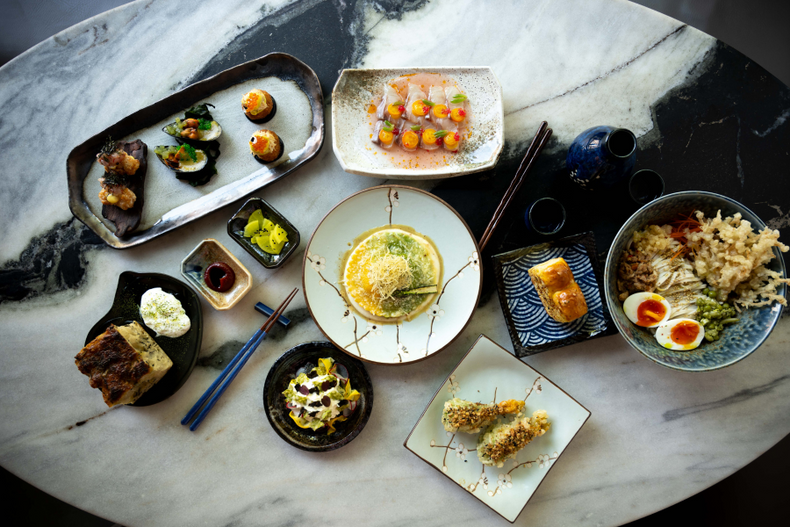Angelina Restaurant on Kaiseki

'Kaiseki is a celebration of seasonality. We have designed the menu to showcase as much diversity as possible in terms of colours, textures, and Japanese and Italian ingredients. Also a variety of different styles of eating — from bitesize finger food and bread to pasta and mains.'
Meet Angelina: the East London restaurant that helped us bring our Japan tableware lookbook to life.
Angelina's menu is inspired by two distinct food cultures: Italian and Japanese.
This fusion is weaved through everything Angelina is: its restaurant design, menu structure, dishes, ingredients...
It's a celebration of both, and the result is epic.
From rosemary and nori focaccia to seabream, kumquat and rhubarb ponzu, this is the most creative menu with some of the boldest flavour combinations we've tried.
Every piece in our Japan tableware collection is hand-painted or hand-finished, meaning that each is unique. Made to be mixed and matched, patterns, colours, and shapes come together in new ways. The result: no two tables will look the same.
Our brief for Angelina was simple: inspire everyone to get creative and create tablescapes that a bold, beautiful, and entirely individual.
Here, we speak to Angelina Co-owner Laura and Sous Chef Khanh.

Co-Founders Laura and Amar with Sous Chef Khanh
What does Kaiseki mean to you?
Laura: Kaiseki comes from Kyoto. It’s a multi-course meal that traditionally took place before tea ceremonies. Because our menu follows a very clear structure, with seven courses (antipasti, chawanmushi, pane, crudo, pasta, binchotan and dolci), Kaiseki fits really well with what we do.
The structure stays the same, but our menu is chef’s choice. Italian and Japanese foods are very ingredient focused and rooted in seasonality. We currently have 13 different dishes on the menu, and these change all the time.
KHANH: Kaiseki is a celebration of seasonality.
We have designed the menu to showcase as much diversity as possible in terms of colours, textures, and Japanese and Italian ingredients. Also a variety of different styles of eating — from bitesize finger food and bread to pasta and mains.
That is our loose framework, but it allows us to be really creative and innovative. We can bring in as many different ingredients as we can in terms of rotating with the seasons.
Today's menu is a celebration of Springtime.
It also reflects diversity that there is across the team in the kitchen and that exists in London. We have access to so much amazing produce — European and Japanese — and we want to bring as much of that in. It’s a reflection of what it is to be a chef in London. Angelina itself is super diverse: we represent 24 nationalities.

Angelina chefs with Japanese paper lanterns over the pass
How does this fusion play out in your restaurant design?
We do everything quite minimally, with accents: Italian marble, Japanese paper lanterns.
Our Co-Owner Josh’s mum Emma Owens is the designer behind Angelina’s interiors and crockery. She works across Asia and Italy, so we have access to some of the best suppliers.

Plating up soy-curd-yolk raviolo & asparagus on a Sakura Blossom plate
What is the dish that best showcases Angelina's approach to fusion?
Khanh: Our pasta course lends itself well to a marrying of these food cultures. Pasta is obviously Italian, but what we put with the pasta (whether it’s filled or on top) can be Japanese-inspired.
Of all the pastas — and they’ve all been amazing — my favourite was a triangoli filled with truffle ricotta and topped with a butter matcha sauce with pistachio. Soy butter was running through it.
The combination of Italian pasta making and matcha butter was something which I would never have thought of. The floral, herbal notes of the matcha worked really well as a savoury course.

Focaccia with nori and rosemary on a black cat plate
Laura: I’ve got to mention the focaccia with nori and rosemary. We’ve tried to take it off the menu, but it always comes back by popular demand. It’s insane.
Are there ingredients or flavours that embody your ethos?
Laura: We love using soy brown butter — it’s super rich in umami with a pleasant nuttiness. We’re using it now on the Crudo course.
We also like playing with ponzu a lot. Traditionally, it’s made with Yuzu, but you can have different citrus variations. Right now, it’s rhubarb season, so we have a rhubarb ponzu.
Khanh: We use a truffle soy sauce on the raw fish Crudo dish, which across the years has been a favourite. It’s always a winner.
Moromi miso is one of Josh’s favourite ingredients ever. A bi-product of soy production, it’s mixed with sesame. It has a very concentrated umami flavour with a pruney fruitiness — savoury and sweet. Japan’s answer to Worcester sauce, but so much better!

Seabream and kumquat on a Yukishino sushi plate with rhubarb ponzu poured from a Sakura Blossom sake jug
What’s next for Angelina?
Laura: There may be a new site on the horizon…
Browse the Japan tableware edit >
Shop the Japanese tableware collection >
Go to Angelina >


